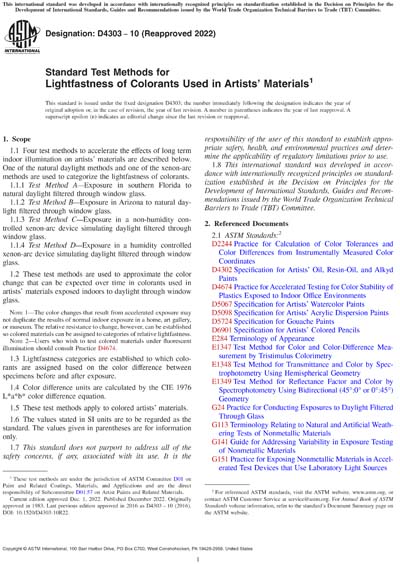Most recent
ASTM D4303-10(2022)
Standard Test Methods for Lightfastness of Colorants Used in Artists' Materials
1.1Four test methods to accelerate the effects of long term indoor illumination on artists' materials are described below. One of the natural daylight methods and one of the xenon-arc methods are used to categorize the lightfastness of colorants.
1.1.1Test Method A - Exposure in southern Florida to natural daylight filtered through window glass.
1.1.2Test Method B - Exposure in Arizona to natural daylight filtered through window glass.
1.1.3Test Method C - Exposure in a non-humidity controlled xenon-arc device simulating daylight filtered through window glass.
1.1.4Test Method D - Exposure in a humidity controlled xenon-arc device simulating daylight filtered through window glass.
1.2These test methods are used to approximate the color change that can be expected over time in colorants used in artists' materials exposed indoors to daylight through window glass.
Note 1:The color changes that result from accelerated exposure may not duplicate the results of normal indoor exposure in a home, art gallery, or museum. The relative resistance to change, however, can be established so colored materials can be assigned to categories of relative lightfastness.
Note 2:Users who wish to test colored materials under fluorescent illumination should consult Practice D4674.
1.3Lightfastness categories are established to which colorants are assigned based on the color difference between specimens before and after exposure.
1.4Color difference units are calculated by the CIE 1976 L*a*b* color difference equation.
1.5These test methods apply to colored artists' materials.
1.6The values stated in SI units are to be regarded as the standard. The values given in parentheses are for information only.
1.7This standard does not purport to address all of the safety concerns, if any, associated with its use. It is the responsibility of the user of this standard to establish appropriate safety, health, and environmental practices and determine the applicability of regulatory limitations prior to use.
1.8This international standard was developed in accordance with internationally recognized principles on standardization established in the Decision on Principles for the Development of International Standards, Guides and Recommendations issued by the World Trade Organization Technical Barriers to Trade (TBT) Committee.
ASTM International [astm]

